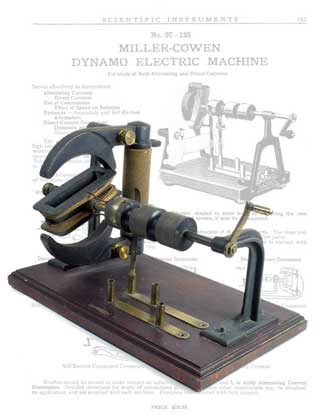 The original form of the Clarke machine, as made by Clarke's firm, is shown in the two versions below. The one on the left, on loan to the Birr Science Museum in Ireland from the apparatus collection at the Irish National University, Galway, shows the laminated permanent magnet which supplies the field, and the crank and pulley (with a missing cord) which drives the rotating coils of wire. On the right-hand side is the Clarke machine in the Transylvania University collection. This is missing the permanent magnet, but shows clearly the rotating coils, each containing 1500 yards of fine, insulated copper wire. At the end is the commutator used to pick off the high EMF which is induced. This example also has a second armature, wound with 20 yards of heavy copper wire. This produces large currents, which produced fat, short sparks. In March 2001 I visited the Garland Collection of Classical Physics apparatus at Vanderbilt University, and there found a Clarke machine in perfect working order. Three views of it are shown below. This instrument is marked "Rhumkorff/À Paris". The Clarke Machine at the left is in the Millington/Barnard Collection in the University Museum at the University of Mississippi in Oxford. There is a good proabability that it was bought by Prof. Barnard in the second half of the 1850s. He bought a good deal of French apparatus, but it is not listed in the 1853 Lerebours et Secretan catalogue from which he made many of his purchases. It has the solid driving wheel of the Clarke machines above, but there is no mechanism on the end of the shaft The commutator leaves are held in the two upright brass rods. Was it made by Clarke? Note that a cover, held on by hooks, once covered the rotating coil.
The original form of the Clarke machine, as made by Clarke's firm, is shown in the two versions below. The one on the left, on loan to the Birr Science Museum in Ireland from the apparatus collection at the Irish National University, Galway, shows the laminated permanent magnet which supplies the field, and the crank and pulley (with a missing cord) which drives the rotating coils of wire. On the right-hand side is the Clarke machine in the Transylvania University collection. This is missing the permanent magnet, but shows clearly the rotating coils, each containing 1500 yards of fine, insulated copper wire. At the end is the commutator used to pick off the high EMF which is induced. This example also has a second armature, wound with 20 yards of heavy copper wire. This produces large currents, which produced fat, short sparks. In March 2001 I visited the Garland Collection of Classical Physics apparatus at Vanderbilt University, and there found a Clarke machine in perfect working order. Three views of it are shown below. This instrument is marked "Rhumkorff/À Paris". The Clarke Machine at the left is in the Millington/Barnard Collection in the University Museum at the University of Mississippi in Oxford. There is a good proabability that it was bought by Prof. Barnard in the second half of the 1850s. He bought a good deal of French apparatus, but it is not listed in the 1853 Lerebours et Secretan catalogue from which he made many of his purchases. It has the solid driving wheel of the Clarke machines above, but there is no mechanism on the end of the shaft The commutator leaves are held in the two upright brass rods. Was it made by Clarke? Note that a cover, held on by hooks, once covered the rotating coil.Zenobe Theopile Gramme (b.1826) demonstrated his generator to the Academy of Sciences in Paris in 1871. Unlike the earlier magneto-electric machines, the Gramme machine used a series of thirty armature coils, placed inside a revolving ring of soft iron. The coils are connected in series, and the junction between each pair is connected to a commutator strip on which two brushes run. The permanent magnets magnetize the soft iron ring, producing a magnetic field which rotates around through the coils in order as the armature turns. This induces an EMF in two of the coils on opposite sides of the armature, which is picked off by the brushes. With thirty coils, the resulting voltage waveform is practically constant, thus producing a near DC signal.
This type of machine needs only electromagnets to produce the magnetic field to become a true Generator.
The instrument at the right is on display at Birr Castle in County Offaly, Ireland, and is on loan from Trinity College, Dublin. The Gramme machine at the left is in the lecture demonstration collection at the physics department at the University of Texas at Austin.
It was imported by Queen of Philadelphia and described in the 1888 Queen catalogue as
GRAMME MAGNETO-ELECTRIC MACHINE No. 16. with crank and multiplying gear. All of the experiments pertaining to a course in physics may be shown with this machine, with the exception of voltaic arc light. Two armatures are necessary with it, one of coarse wire for quantity [large currents], and one of fine wire for intensity [high voltages], with some experiments being more successful with the one, and some with the other ... It is equal to about ten cells of Bunsen's Battery, and is very convenient for laboratory use, being easily moved and worked. Price on application."
Enlaces:
Spark Museum

No hay comentarios:
Publicar un comentario